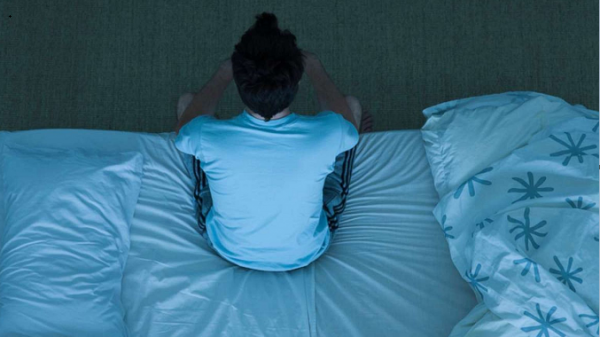Insomnia: the common sleep disorder

- Update Time : Thursday, September 3, 2020
- 186 Time View

Sleep quality is a key component of a healthy lifestyle. We spend around a third of our lives asleep or at least we should. And while sleep requirements vary slightly from person to person, experts agree that most healthy adults need from seven to nine hours of sleep per night.
Unfortunately, many of us fall short of that target. According to the National Institutes of Health, insomnia affects about one-third of the general population, making it the most common sleep disorder in the United States. Here’s what you need to know about the sleep condition, how to identify it, and what treatment options look like.
What exactly is insomnia?
Insomnia is a sleep disorder that can cause issues with falling asleep, staying asleep, or both, according to the US National Library of Medicine’s MedlinePlus resource. It essentially leads to poor sleep quality or getting too little sleep.
The disorder may be classified as chronic, or long-term insomnia; or acute, or short-term insomnia. “In adults, chronic insomnia is defined as the inability to fall or stay asleep, or waking up earlier than desired,” Alcibiades Rodriguez, MD, medical director of the Comprehensive Epilepsy Center-Sleep Center at NYU Langone Health, tells Health. “It has to be present at least three times per week for three months.” On the other hand, acute insomnia lasts for less than three months, and may only persist for a few days or weeks.
Insomnia can also be either a primary or secondary issue. While primary insomnia occurs in isolation and is often a condition influenced by genetics that may start in childhood, secondary insomnia often develops due to another underlying condition, Brandon Peters-Mathews, MD, a sleep medicine doctor at Virginia Mason Medical Center, Seattle, and author of Sleep Through Insomnia, tells Health.
“Primary insomnia may be due to an underlying predisposition that contributes to increased wakefulness at night,” Dr. Peters-Mathews says. “Secondary insomnia may develop in response to environmental disturbances, or due to psychosocial stress, and is often linked to another sleep disorder, such as sleep apnea or restless legs syndrome. Secondary insomnia may also occur due to anxiety, chronic pain, or other medical problems.”
There are other ways to classify insomnia, too, such as comorbid insomnia, when the sleep disorder occurs with another condition. “Insomnia is closely related to mood disorders like anxiety and depression,” Dr. Rodriguez says. Other medical conditions, such as arthritis or back pain, may cause discomfort at night, which can make it hard to sleep. Other classifications include onset insomnia, which is difficulty falling asleep at the beginning of the night, and maintenance insomnia, which is the inability to stay asleep (or waking up during the night and struggling to get back to sleep).
What are the symptoms of insomnia, and what causes it?
According to MedlinePlus, the key symptoms of insomnia include:
# Lying awake for a long time before you fall asleep.
# Sleeping for only short periods of time.
# Being awake for much of the night.
# Feeling as if you haven’t slept at all.
# Waking up too early.
Some people are also at more risk for insomnia, per MedlinePlus—that includes women and older adults. African Americans are also more prone to sleep issues, as are those who have schedules that include a lot of travel, and people who do shift work.
Regardless of whether insomnia is acute or chronic, stress is often at the root of it. “Acute insomnia is often caused by a stressful life event, which may be good, like a new job, marriage or baby; or bad, like a bereavement, breakup or illness, Beth A. Malow, MD, a professor in the department of neurology and pediatrics and director of the sleep disorders division at Vanderbilt University Medical Center, tells Health.
Any of those stressors may underpin a case chronic of chronic insomnia, but there’s normally more involved, Dr. Malow says. For instance, a predisposition to not getting over acute insomnia (older adults in particular may have more difficulty), or chronic illness. Sometimes there’s an underlying sleep disorder like sleep apnea, and insomnia may also run in families.
How is insomnia treated?
Acute insomnia often resolves without treatment, or following implementation of lifestyle changes. Dr. Peters-Mathews recommends identifying stress, environment, or medical changes that may disturb sleep. He also suggests keeping a fixed wake time with an alarm clock (even on days off), getting 15 minutes of sunlight immediately upon awakening, and going to bed feeling sleepy with no more than seven to eight hours of total time in bed.
There are also a couple of things not to do. “Don’t take naps and avoid caffeine and alcohol consumption,” Dr. Peters-Mathews says. “And if you’re awake for more than 15 to 20 minutes in bed, get up and do something relaxing and come back to bed when you’re feeling more sleepy.”
However, lifestyle changes are often insufficient to correct chronic insomnia, which is usually a lifelong problem. “We can control it, but not cure it,” Dr. Rodriguez explains. “But remember, in medicine we don’t cure many things. For example, we don’t cure diabetes or high blood pressure, but we control them.”
The experts agree with the American College of Physicians and the American Academy of Sleep Medicine, which recommend cognitive behavioral therapy for insomnia (CBT-I) as the first-line treatment for chronic insomnia.
Some doctors may also prescribe medication for insomnia, but Dr. Peters-Mathews believes sleeping pills should have a limited role in treatment and says they’re not recommended for use beyond two weeks. “I tell my patients, ‘You don’t take medication to feel hungry, why would you need medication to feel sleepy?’” he says. “Sleep is a natural process that can be promoted with the education and behavioral changes outlined in a standard CBT-I program.”
Dr. Malow suggests starting with melatonin, a synthetic version of the hormone produced naturally in the body. “Talk with your provider first to make sure it’s safe,” she says. Past that, many medications are approved for long-term use for insomnia, such as Zolpidem (Ambien) and Eszopiclone (Lunesta). But there are side effects to be aware of. “Be careful of falls, confusion, amnesia (short-term memory loss), and sleepwalking with these drugs,” Dr. Malow says.
If insomnia becomes chronic, it can have a huge impact on numerous aspects of their life, including work, education, and relationships. It is also considered a contributing risk factor for physical and mental health issues, including cardiovascular diseases, chronic pain syndrome, depression, anxiety, diabetes, obesity, and asthma. Because of that, it’s important to see your health care provider to talk about your sleep issues, and get the treatment necessary to get them under control.





















